|
| Author |
Message |
    
johnny
Senior Member
Username: johnny
Post Number: 129
Registered: 03-2006
| | Posted on Saturday, December 22, 2007 - 04:26 pm: | 




|
Can anyone tell me what make boat this is? I think it has a little brigg's as the engine. I plan on installing a 2hp Detroit if I get the boat and I'm pretty sure I will. I have no experience with wooden boats at all. However I do have experience with composite layup such as fiberglass, etc.. and I have worked with some hard woods before. I'm a machinist by trade and have restored a few of the old flywheel engines over the years so I don't believe I will have any problems with the engine. I will probably be asking a lot of questions about the wood working, installing the engine and shaft, etc.. When I start working on this project.
So any advice would be grateful.
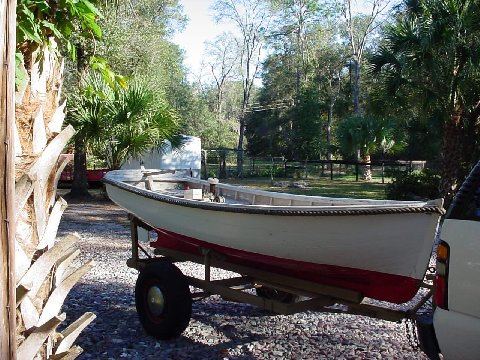
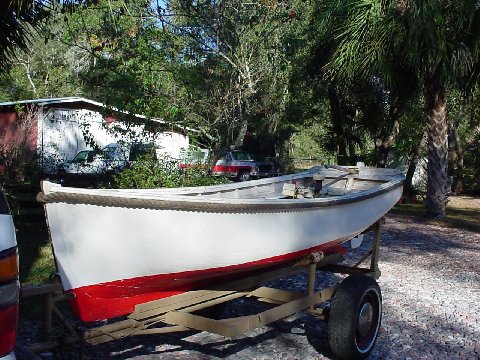
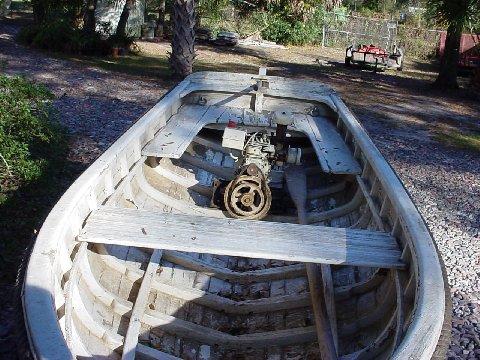
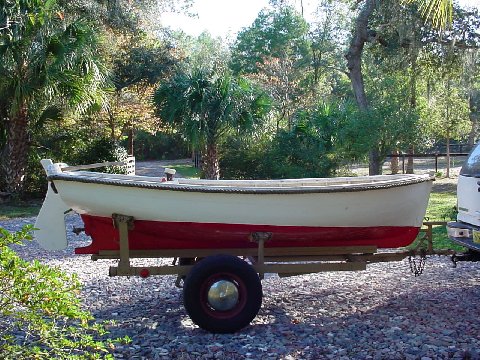 |
    
johnny
Senior Member
Username: johnny
Post Number: 130
Registered: 03-2006
| | Posted on Saturday, December 22, 2007 - 04:29 pm: | 




|
For some reason that last photo really makes the boat look short but it is 13 or 14 ft long. I'm not sure how wide it is. I will post more info when I get the boat. |
    
miro
Senior Member
Username: miro
Post Number: 303
Registered: 11-2001

| | Posted on Sunday, December 23, 2007 - 07:18 am: | 




|
The hull looks to be in good shape.
You'll may find some rotted plank sections.
Replacing the rotted section takes some careful and patient work - not difficult - just calm, thoughful work. Scarf joints I think are better than butt joints backed up by blocks, but that is a peresonal preference.
The most difficult part - the bow stem looks to be OK, so that is good. Please, please do NOT , repeat do NOT, fiberglass the hull.
That is the kiss of death for a wooden boat. It is OK for the first couple of years, but then moisture will seep in between the planking and the glass and will never dry out, giving rot a beautiful place to start.
It is better to scrape and sand the old paint off the bottom every 4 -5 years, and then re-paint it.
For small section of wood that is sort of OK, but gettng punky, there is a runny expoxy that I have used Git Rot, that will stabilize the section. By small I mean 2 or 3 iches or so.
For sure, you should scrape and sand the bottom whe you get the boat, appply a coat or two of preservative and then re-paint.
I've mixed about 10% preservative into the bottom paint to help keep things sound.
Once of the things that I am careful of, is to make sure that I clean out the bilge every month or two. You'd be surprised how much dirt and other crud gets tracked into the boat on shoes and boots. If you don't clean it out, you, in effect have a compost pile where rot will start.
Once I've washed the dirt out and the boat is dry, I apply some clear preservative, (zinc napthanate) to essentially kill all the bacteria that would rot the wood.
There are many wooden boats that are well over 50 years old - it is very low tech stuff - a saw, a plane, some chisels, nails, screws and a hammer and screwdriver.
All the best for Christmas
miro |
    
johnny
Senior Member
Username: johnny
Post Number: 131
Registered: 03-2006
| | Posted on Sunday, December 23, 2007 - 08:21 am: | 




|
Miro, thanks for the reply. The only place I was thinking of using fiberglass & epoxy would be around the engine mount area. Is this good idea or not? It's probably going to be towards middle or the end of the year before I get started on restoring the boat because I have two engines I'm restoring at this time. The boat will be in the garage so it should be ok. Something else I was wondering about how do you determine where the engine should be mounted length wise to the boat? Also the angle of the prop and shaft? I realize this is not a speed boat but I want to do it the correct way. |
    
johnny
Senior Member
Username: johnny
Post Number: 133
Registered: 03-2006
| | Posted on Friday, December 28, 2007 - 07:38 pm: | 




|
Here are a few more photos of the little boat I just got. It is 13ft long, 4ft 6in wide. 5hp Tacumseh engine, 12 inch prop, pitch? The drive shaft is 3/4 inch stainless and exits through a bushing with a packing nut and a grease sert. Is this exceptable? It appears that most of the wood on the boat is good.
Any Ideas as to the age? or what the boat started out as? Life boat, surf boat, sail boat, etc...? I know its not a very early inboard but I hope to fix that problem.
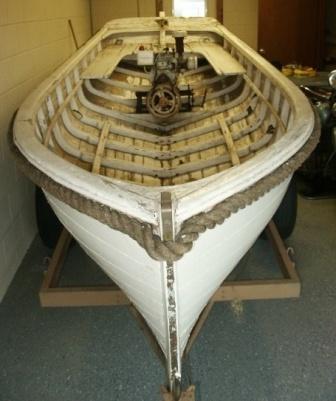
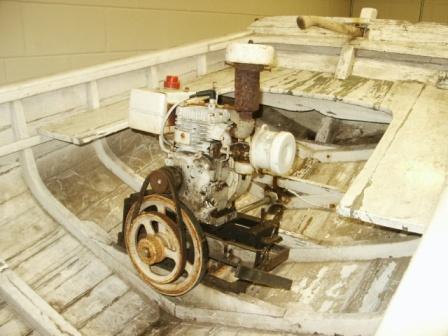
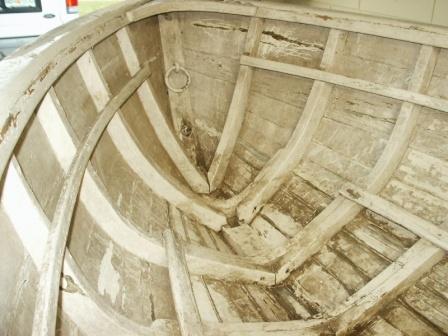
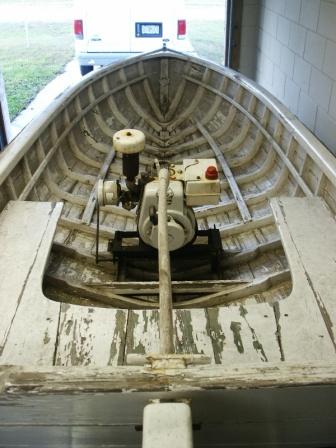
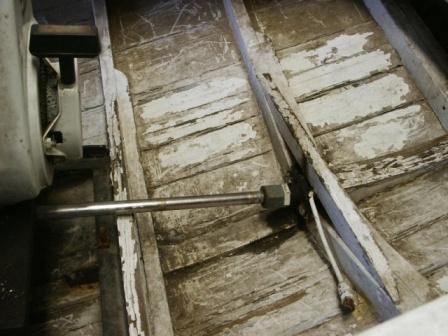
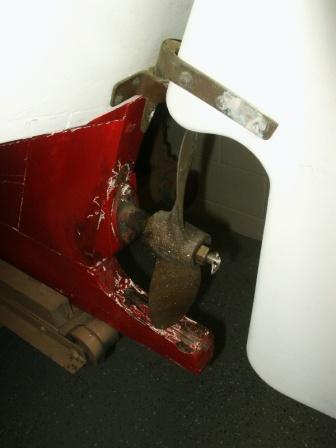
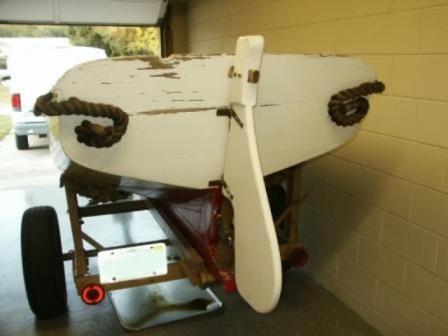 |
    
johnny
Senior Member
Username: johnny
Post Number: 134
Registered: 03-2006
| | Posted on Friday, December 28, 2007 - 07:58 pm: | 




|
Can anyone recommend a good book on restoring boats for the beginner? I need to know stuff like what kind of calk to use for joints, wood glues, paints, wood treatment, nails, screws, woods, the best way to secure and align engine and mounts, how to strip the boat, etc... |
    
miro
Senior Member
Username: miro
Post Number: 306
Registered: 11-2001

| | Posted on Sunday, December 30, 2007 - 09:51 pm: | 




|
It looks to be in good condition.
THe drive arrangment is innovative to say the least.
For stripping old paint . finish, I found that a runny chemical stripper worked over an area of about 2 ft x 2 ft worked well. I used a small jet hose, - not quite high pressure jet setup - 85 psi tops, to clean off the old finish once it was softened up. Eye protection and body protection is vital.
Once the old finish is gone inside and out, you'll see the through hull screws that hold the engine bed to the hull.
With the old pain off, yu might be wise to inspect the fasteners and make sure they're tight to the ribs. If tapered copper nails are used, you might consider replacing them with bronze screws that have a taper. Don't worry too much about how tight the fasteners fit as loing as they are snug. Once the water gets into the wood when you put it in for the first time, the wood swells and seals the fasteners.
You can then remove the old engine bed.
Installing the new one will take some patience. Cut and try is a good approach, with soft wood, and then once you have the engine bed stringers figured out, use them as a pattern for decent white oak stringers. You'll probabaly well advised to extend the engine bed stringers fore and aft of what you have now. The engine bed strngers should be at least 36 in long fastened to the hule every 6 inches.
Glues will hold for a while but with the wet dry cycle and the expansion and shrinkage of the wood, the glue joints inevitably fail. I use poluurethane bedding compound SikaFlex, when I made any wood to wood joints. It holds well yet remains flexible. You want to see a small amount of squeeze out too, when you tightem down the fasteners.
Good quality oil based paint will work well. I use a marine grade product called Easypoxy by Petit's
It is shown as a top side paint, but I use it on my boat bottom anyway and it seems to work well.
There's always the option of a copper based poisoinous paint that prevents growth of crud on the bottom. I usually scrub the bottom a couple of times a season with a stiff brush to get rid of the stuff that grows.
Caulking starts with cleaning out as best you can, the old stuff. You'll probably end up making some special tools to rake the old stuff out This is best done when the hull is bare and dry. Don't let it get too dry for fear of a plannk spliting. If you must have the boat in a heated storage area, spray if with water and keep it tarp'ed to prevent it drying out.
Once you've raked out the old caulk, virtually any mairine grade caulk will do the job.
Wooden Boat magazine is a good place to look for suppliers of caulk, bedding compound and paint.
As a first pass, I think the prop might work with your lower speed engine because of the belt reduction drive. A 3/4 in shaft is probabaly good for up to 3 HP and about 800- 900 RPM.
Messing with the deadwod bore for the shaft and the shaft alignment is a risk. For now, I'd leave it alone and work with what you have. You've got enogh to do as it is.
miro |
    
johnny
Senior Member
Username: johnny
Post Number: 139
Registered: 03-2006
| | Posted on Saturday, January 05, 2008 - 10:38 am: | 




|
Here are a few photos of the engine I plan on putting in the boat shown above. Manufacture: Detroit Engine Works. 2hp 2 cycle, Bore: 3 in. Stroke: 3.5 in. Crankshaft Dia: 1-7/32 in., Weight: 100 lbs., Carb: Lunkenheimer with throttle control., Output shaft dia: .750, manual spark advance & retard. Engine runs forward or reverse.
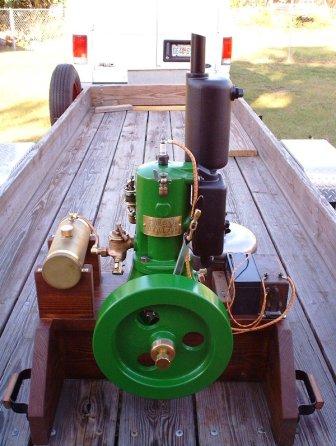
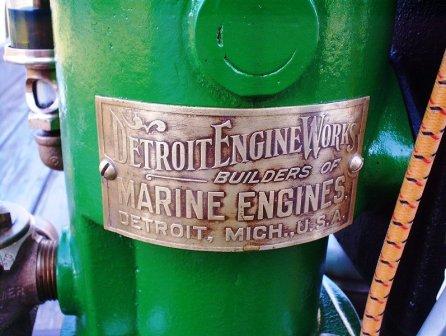
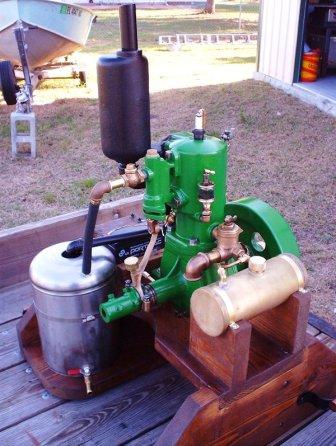 |
    
johnny
Senior Member
Username: johnny
Post Number: 147
Registered: 03-2006
| | Posted on Wednesday, January 23, 2008 - 07:58 pm: | 




|
I found out through the wooden boat forum and the Florida Maritime Museum (Roger Allen)that they are pretty sure my boat is an original Abaco dinghy that was made by one of two companies over in the Bahamas (Abacos Islands) It was originally a sail boat and Probably built sometime around the 1950's -1960's. Mostly made out of red or white cypress.
The Florida Maritime Museum is currently restoring three of the Abaco dinghies in their shop. Mr Allen invited me to come over & look at the boats they are restoring and also to bring my boat and they would try to answer any questions I might have about it and give me some tips on restoring the boat. Roger Allen heads up the Florida Maritime Museum and is a direct descendant of the family that originally designed and built the first Abaco dinghies back in the late 1800's or early 1900's. The boats were originally used for sponge and conk harvesting and some other uses.
More information:
I got a name and telephone number to the elderly gentlemen (Earl) that owned the boat previous to the man that I got the boat from. I called the gentlemen the other night and this is the story he gave me about the boat.
Earl said that he thought the boat was a Abaco dinghy but he wasn't sure. Him and a friend found the boat in rainy lake in the state of Minnesota sunk in about 8 or 10 foot of water by a dam. They raised the boat brought it home. They had to make Jigs to keep it from warping as it dried out. Sometime later Earl moved to Florida and brought the boat with him. He then restored the boat including adding a new rudder, engine and drive that you see in the photos. After the restoration the boat was used a lot off the coast of Miami Florida for fishing, diving, snorkeling, etc.. As Earl got older the boat most of set in the barn for some time because the paint and caulk is dried and cracked pretty bad. However I don't think the wood is to bad.
The End..
Does anyone know of a boat that has been restored after being sunk for a while? Is this a good thing or bad when it comes to wood boats? |
|
|
|


|


